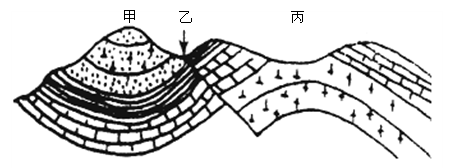读地质构造图,回答下列问题。(每空2分,共10分)

(1)写出图中地质构造名称:甲 ,乙 ,丙 。
(2)丙地地质构造顶部岩层缺失的原因是 。
(3)建设地下隧道应选址在甲、乙、丙处的 处为好。
(1)向斜 断层 背斜
(2)外力侵蚀
(3)丙
本题考查地质构造。
(1)图示甲处中间岩层向下凹,判断为向斜;乙处岩层发展断裂错位,判断为断层;丙处中间岩层向上拱起,判断为背斜。
(2)丙处为背斜形成之初应该形成山岭,但由于背斜顶部受张力作用,故岩性疏松,可从外力作用角度分析其受长期的侵蚀而成谷。
(3)背斜的拱形弯曲能起支撑作用,符合力学原理,适宜建设隧道。

